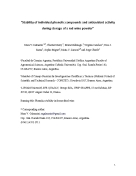Por favor, use este identificador para citar o enlazar este ítem:
https://repositorio.uca.edu.ar/handle/123456789/5442| Título: | Stability of individual phenolic compounds and antioxidant activity during storage of a red wine powder | Autor: | Galmarini, Mara Virginia Maury, Chantal Mehinagic, Emira Sanchez, Virginia Baeza, Rosa Mignot, Sophie Zamora, María Clara Chirife, Jorge |
Otros colaboradores: | Universidad Católica Argentina. Facultad de Ciencias Agrarias | Palabras clave: | POLIFENOLES; VINO; POTENCIAL ANTIOXIDANTE; RESVERATROL; INGENIERIA EN ALIMENTOS | Fecha de publicación: | 2012 | Cita: | Galmarini, M., Maury, Ch., Mehinagic, E., Sanchez, V., Baeza, R., Mignot, S., Zamora, M. y Chirife, J. 2012. Stability of individual phelonic compounds and antioxidant activity during storage of a red wine powder [en línea]. Postprint del artículo publicado en Food and bioprocess technology, diciembre 2012. DOI 1 0 . 1 0 0 7/s 1 1 9 4 7-0 1 2- 1 0 3 5-y Disponible en: https://repositorio.uca.edu.ar/handle/123456789/5442 | Resumen: | Abstract: The addition of maltodextrin DE 10 to red wine (Cabernet sauvignon) followed by freeze-drying allowed to obtain a free-flowing (dealcoholized) wine powder (WP) having a phenolic concentration about 3.6 times higher than the original liquid red wine. The powder, having a water activity (aw) of 0.053 and 0.330 was stored at 28ºC and 38ºC and the content of ten different phenolic compounds was determined by HPLC. Caftaric acid, quercetin 3-glucoside, caffeic acid, gallic acid and resveratrol contents in the WP stored at 28 and 38 ºC, remained almost constant during 70 days of storage, while epicatechin gallate, catechin, malvidin 3-G and epicatechin showed slight losses (about 15- 25%) during storage. On the contrary, epigallocatechin experienced a strong loss of concentration (around 61% loss) during storage at the same conditions. A moderate decrease of antioxidant activity, determined by free radical scavenging capacity of the DPPH* and ferric reducing antioxidant power (FRAP) was observed along storage. This decrease was more important at higher temperature (38ºC) and higher aw (0.33). These results would allow the feasibility of using this wine powder as a healthy ingredient in alcohol-free powder drinks | URI: | https://repositorio.uca.edu.ar/handle/123456789/5442 | Disciplina: | INGENIERIA EN ALIMENTOS | Derechos: | Acceso Abierto |
| Aparece en las colecciones: | Artículos |
Ficheros en este ítem:
| Fichero | Descripción | Tamaño | Formato | |
|---|---|---|---|---|
| stability-individual-phenolic-compounds.pdf | 294,18 kB | Adobe PDF |  Visualizar/Abrir |
Visualizaciones de página(s)
228
comprobado en 30-abr-2024
Descarga(s)
572
comprobado en 30-abr-2024
Google ScholarTM
Ver en Google Scholar
Este ítem está sujeto a una Licencia Creative Commons

